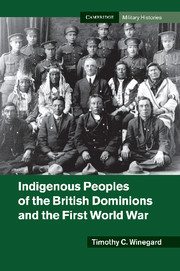Book contents
- Frontmatter
- Contents
- Figures
- Maps
- Tables
- Acknowledgements
- Note on the text
- Introduction
- 1 Colonization and the settler state
- 2 Racial constructs and martial theories
- 3 Precedents of military pragmatism
- 4 Dominion defence acts
- 5 1914: Subjugated spectators
- 6 1915–1916: King and country call
- 7 1917–1918: All the King’s men
- 8 Indigenous soldiers
- 9 The home front
- 10 Peace with prejudice
- Conclusion
- Bibliography
- Index
- References
2 - Racial constructs and martial theories
Published online by Cambridge University Press: 05 June 2014
- Frontmatter
- Contents
- Figures
- Maps
- Tables
- Acknowledgements
- Note on the text
- Introduction
- 1 Colonization and the settler state
- 2 Racial constructs and martial theories
- 3 Precedents of military pragmatism
- 4 Dominion defence acts
- 5 1914: Subjugated spectators
- 6 1915–1916: King and country call
- 7 1917–1918: All the King’s men
- 8 Indigenous soldiers
- 9 The home front
- 10 Peace with prejudice
- Conclusion
- Bibliography
- Index
- References
Summary
The paternalistic policies regulating indigenous peoples were dependent upon contemporary racial and class theories persistent in European dialogue and culture, imported by settler societies:
Colonial settlers, the offspring of European imperialism, refused to integrate with the indigenous population. Moreover, they kept Europe as their myth of origin and as a signifier of superiority even when formal political ties and/or dependency with European colonial powers had been abandoned. This sense of identification with the ‘mother country’ has not, however, mitigated the unevenness and fragility of settler identities, which were often forged in defence against metropolitan contempt.
In the absence of large noble and gentry populations, the original convict and primarily lower-class British settlers of the ‘white Dominions’ instinctively filled the vacuum. While the colonies afforded both new opportunities and the ability to transcend the regimented tiers of European society, the hierarchies did not vanish. Settlers found in indigenous peoples, Asian labourers and inferior immigrants alternatives to fill the lower rungs of class and racial hierarchies.
The concept of martial races – the belief that certain identifiable peoples or societies had an innate and exceptional capacity for war – was a construct engineered in India and exported across the British and other European empires. Martial race theories were derived from a pragmatic approach to internal state security, as a consequence of the 1857 Indian Mutiny and the subsequent shifting of sepoy ratios in the Indian Army of the British Raj to favour men from the Punjab, Nepal and the Northwest Frontier (Afghanistan).
- Type
- Chapter
- Information
- Publisher: Cambridge University PressPrint publication year: 2011



